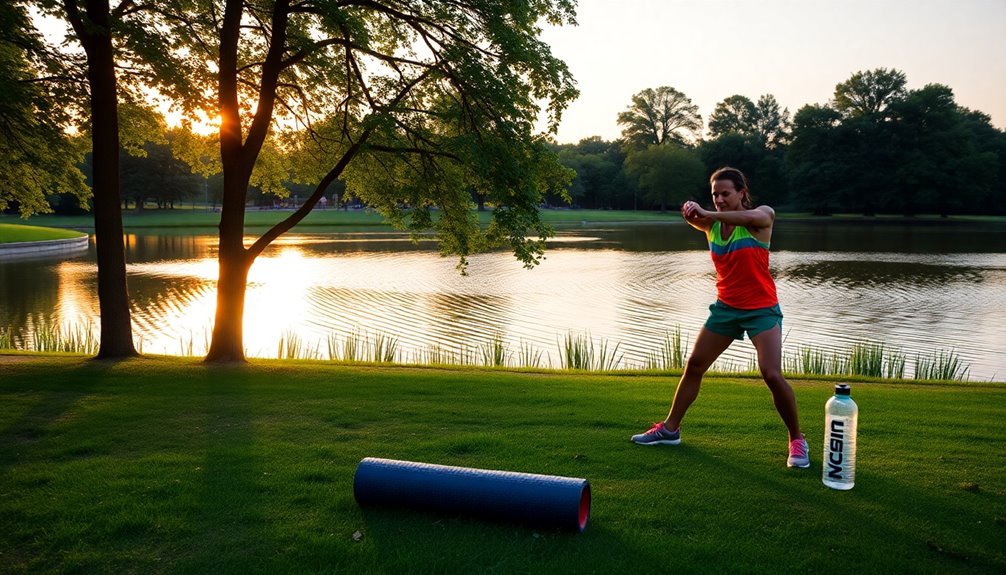To enhance your running performance and minimize injury risks, start each session with a 5-10 minute warm-up of light aerobic activity like brisk walking or slow jogging. Incorporate dynamic stretches to increase flexibility. After your run, cool down with 5-10 minutes of walking and perform static stretching to aid recovery. Consistent warm-ups and cool-downs not only prepare your body but also promote flexibility and relaxation. Discover how to tailor these routines for best results.
Key Takeaways
- Start with 5-10 minutes of light aerobic activity like brisk walking or slow jogging to elevate heart rate.
- Incorporate dynamic stretches such as walking lunges and high knees to enhance flexibility and prepare muscles.
- Gradually increase running speed during the warm-up to acclimate the body to exertion without overexerting.
- After your run, cool down with 5-10 minutes of walking or slow jogging to gradually lower heart rate.
- Follow the cool-down with static stretching to reduce muscle soreness and promote recovery.
Importance of Warm-Ups

When you warm up before a run, you're not just going through the motions; you're actively preparing your body for the challenge ahead. A proper warm-up routine is essential for engaging your muscle groups, joints, and tendons, considerably reducing the risk of injury.
By increasing blood flow and oxygen delivery, you enhance flexibility and overall performance. This relaxed approach helps prevent early fatigue and burnout as your body gradually acclimates to physical exertion.
Research shows that runners who commit to warm-ups consistently demonstrate better endurance and performance compared to those who skip this critical step. Just a 5-10 minute warm-up can lead to improved readiness for intense workouts and overall running efficiency, making it a fundamental part of your routine.
How to Do Running Warmups

To effectively prepare for your run, start with 5-10 minutes of light aerobic exercise, like brisk walking or slow jogging, which activates your muscles and boosts blood flow.
After that, incorporate dynamic stretching, such as walking lunges and high knees, to enhance flexibility and readiness.
Gradually increase your running speed during the warm-up, and listen to your breath to guarantee you're not overexerting yourself too soon.
Maintain proper running posture throughout the warm-up to set yourself up for success.
Avoid rushing this process; taking your time considerably reduces the risk of injury and improves your overall performance.
Benefits of Running Warmups

Incorporating warm-ups into your running routine not only enhances performance but also greatly reduces the risk of injury. When you engage in warm-ups, you increase blood flow and oxygen delivery to your muscles, which boosts endurance and overall performance.
A proper warm-up routine raises muscle temperature, improving flexibility and range of motion, essential for effective running mechanics. Dynamic stretches and light aerobic exercises prepare your cardiovascular system, preventing sudden spikes in heart rate.
Furthermore, warm-ups help you mentally gear up for the physical activity ahead, creating a smoother shift from rest to running. By consistently including warm-ups in your routine, you'll notice a significant improvement in both your running experience and your results.
Importance of Cool-Downs

Although many runners focus primarily on the warm-up, neglecting the cool-down can undermine your performance and recovery. A proper cool-down routine, which includes 5-10 minutes of walking or slow jogging, helps gradually lower your heart rate and prevents light-headedness after intense exercise.
Engaging in a post-run stretching routine enhances overall recovery and reduces muscle soreness for key muscle groups like your quadriceps, hamstrings, and calves. Research shows that a gradual cool-down redistributes blood flow, preventing blood pooling and aiding muscle recovery.
Skipping this phase can lead to increased muscle tightness and delayed onset muscle soreness (DOMS), making a consistent cool-down essential for long-term performance improvement and smoother shifts from exercise to recovery.
How to Do a Proper Cooldown

After you finish your run, it's crucial to shift your body back to a state of rest with a proper cooldown. Start by walking or slow jogging for 5-10 minutes to lower your heart rate. Focus on static stretching for major muscle groups, holding each position for 30-60 seconds to enhance flexibility and aid recovery. Don't forget to hydrate with water or electrolyte drinks to replenish lost fluids. If you want to alleviate muscle tightness, consider foam rolling after your cooldown. Keep in mind that the cooldown duration should match your workout intensity—longer for more intense runs.
| Activity | Duration | Purpose |
|---|---|---|
| Walking/Jogging | 5-10 minutes | Lower heart rate |
| Static Stretching | 30-60 seconds each | Enhance flexibility |
| Foam Rolling | 5-10 minutes | Promote circulation and recovery |
| Hydration | As needed | Replenish lost fluids |
| Adjust Duration | As needed | Align with workout intensity |
Benefits of a Running Cooldown

A proper cooldown is crucial not just for your immediate recovery but also for your long-term performance as a runner. By cooling down, you help your body shift smoothly from high-intensity exercise to a resting state.
This practice offers several benefits:
- Maintains blood flow, preventing light-headedness
- Gradually lowers heart rate, reducing fainting risks
- Reduces delayed onset muscle soreness (DOMS) by promoting circulation
- Enhances overall recovery and flexibility
Incorporating a cooldown into your routine allows your muscles to relax and recover effectively after exertion.
This simple yet essential step not only aids in flushing out metabolic waste but also contributes to improved performance over time.
Stretching Tips for Your Post-Run

Cooling down is just the beginning of your post-run recovery. Stretching is essential for enhancing flexibility and preventing stiffness. Spend a few easy minutes on each stretch, holding for 15-30 seconds. Avoid bouncing, and remember to stretch both sides equally to maintain balance. Focus on feeling slight tension without pain, and incorporate deep breathing to enhance relaxation.
Here's a quick reference table for your post-run stretching routine:
| Stretch | Duration (seconds) | Focus Area |
|---|---|---|
| Hamstring Stretch | 15-30 | Hamstrings |
| Quad Stretch | 15-30 | Quadriceps |
| Calf Stretch | 15-30 | Calves |
| Hip Flexor Stretch | 15-30 | Hip Flexors |
Make stretching a regular part of your routine!
Common Mistakes to Avoid

While many runners understand the importance of warm-ups and cool-downs, they often make critical mistakes that can hinder their performance and recovery.
To guarantee you get the most out of your warmup and cooldown, avoid these common pitfalls:
- Skipping warm-ups: This can increase your injury risk, as your muscles aren't prepared for running.
- Using static stretches: They can reduce muscle tone if done improperly before activity; focus on dynamic stretching instead.
- Neglecting cool-downs: Skipping this step may lead to dizziness from rapid drops in heart rate.
- Overlooking hydration: Failing to rehydrate can hinder recovery and prevent muscle soreness.
Remember to stretch until you feel a comfortable range to keep your muscles balanced and prevent imbalances!
Incorporating Warm-Ups and Cool-Downs Into Your Routine

To get the most out of your runs, establishing consistent warm-up and cool-down habits is essential.
You'll want to pay attention to timing and duration, ensuring each routine lasts about 10-15 minutes.
Tailoring your warm-ups and cool-downs to match the intensity of your workouts can make a big difference in your performance and recovery.
Establishing Consistent Habits
How can you guarantee that warm-ups and cool-downs become an integral part of your running routine? Start by dedicating at least 10-15 minutes before and after each run.
Here are some strategies to help you establish this habit:
- Incorporate dynamic stretches, like high knees and walking lunges, to engage specific muscle groups.
- Use a checklist or reminder system to reinforce your warm-up and cool-down practices.
- Track your progress and how your body feels after five minutes of warm-ups and cool-downs.
- Set a goal to include these routines in your training plan for at least four consecutive weeks.
Timing and Duration
Establishing a routine of warm-ups and cool-downs is just the beginning; timing and duration play a key role in maximizing their effectiveness. Aim for at least 10-15 minutes for both warming up and cooling.
Start your warm-up with 5-10 minutes of easy aerobic activity, like jogging or brisk walking, to elevate your heart rate. Follow this with dynamic stretches targeting key muscle groups to prepare your body for exertion.
After your run, dedicate 5-10 minutes to cooling down with walking or slow jogging. This gradual decrease in intensity helps lower your heart rate and aids recovery.
Consistently incorporating these routines can greatly reduce your risk of injuries and muscle soreness, setting you up for long-term success as a runner.
Tailoring to Intensity
As you plan your running routine, understanding how to tailor your warm-ups and cool-downs to the intensity of your workouts can greatly enhance your performance.
- For steady runs, focus on dynamic exercises to improve range of motion during a 10-15 minute warm-up.
- For tempo or interval sessions, include specific drills to prepare your muscles for faster efforts and reduce injury risk.
- After intense workouts, engage in a 10-15 minute cool-down with light aerobic activity.
- Follow the cool-down with static stretching to promote recovery and flexibility.
Frequently Asked Questions
How to Warm-Up and Cool-Down From Running?
To warm up before running, start with 5-10 minutes of light aerobic exercise to get your heart rate up.
Follow this with dynamic stretches, focusing on your hips, quadriceps, and shoulders.
After your run, cool down by walking or slowly jogging for another 5-10 minutes. This helps your heart rate return to normal.
Incorporate static stretching afterwards, holding each stretch for 15-30 seconds, to improve flexibility and reduce muscle soreness.
How Do Professional Runners Warm-Up?
You might think professional runners just lace up and sprint off, but their warm-up is far from that!
They kick things off with 5-10 minutes of light aerobic activity, like jogging, to rev up their heart rates.
Then, they plunge into dynamic stretches—think lunges and leg swings—that target key muscle groups.
Some even throw in plyometric drills, like high knees, to really get those muscles firing before a big race or workout.
Is a 10 Minute Jog a Good Warm-Up?
Absolutely, a 10-minute jog is a great warm-up! It gradually elevates your heart rate and increases blood flow to your muscles, prepping them for more intense activity.
This light aerobic exercise not only boosts your endurance but also enhances flexibility by warming up your muscles.
Plus, it helps you mentally shift from rest to action, setting a positive tone for your workout.
Consistently doing this can really improve your overall performance!
What Are Warm-Up and Cool-Down Exercises?
Warm-up exercises are the energetic start to your workout, while cool-down exercises gently ease you back to rest.
You'll engage in dynamic movements during warm-ups to boost blood flow and flexibility.
After your session, cooling down involves light jogging or walking, shifting to static stretching.
Both are essential: warm-ups prepare you for action, and cool-downs aid recovery, ensuring you're ready for your next challenge without the risk of injury.
Conclusion
Incorporating effective warm-up and cool-down routines into your running practice is like laying a strong foundation for a house—you need it to withstand the storms. By preparing your body for the journey ahead and gently easing it back afterward, you're not just enhancing performance; you're nurturing your passion for running. So, lace up, take those essential steps, and watch your love for the road flourish, mile after mile. Your body will thank you as you run toward new horizons.








